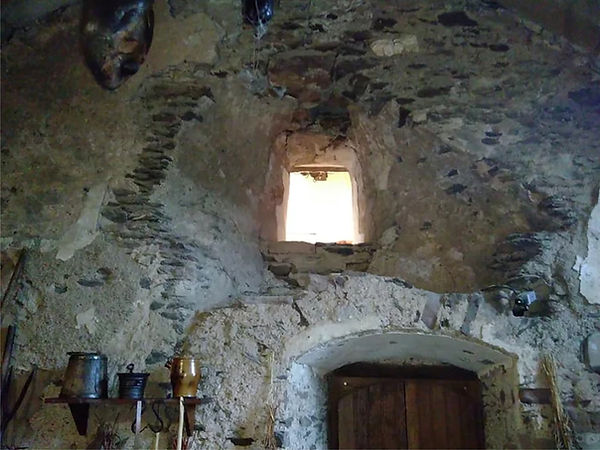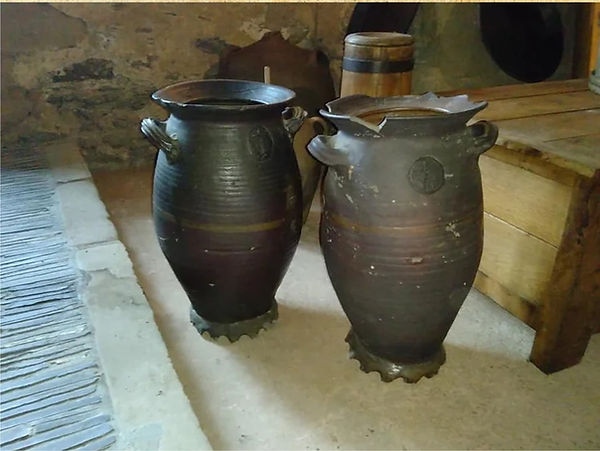
stately kitchen
(new kitchen, great kitchen)


This kitchen was installed inside an existing tower and replaced the old kitchen
to supply the court with food at an unknown date, possibly as early as the late 12th / early 13th century. It seems reasonable to assume that the great hall constructed at this time necessitated a new bigger kitchen facility. By consequence the kitchen communicates with a service hatch with the great hall.
Behind the wall on the left there were food stores in the lower storey, and the chief cook's apartment in the upper storey. Possibly there once have been further service rooms to the right too. Down from the kitchen towards the great hall lies the well, and behind the well a 3rd kitchen (no more visible today) was installed in the 14th century.
A huge chimney (reconstructed only unto the 2nd storey) covered a fireplace of approximately 20 x 13 feet (6 x 4 metres). The furnace visible inside the wall also made use of this chimney.
medieval cuisine

The medieval european cuisine first appeared soon after the fall of the roman empire, developped (with little divergences through western Europe) and lasted until mid 17th century. It was then replaced by modern european cuisine, with considerable national and regional divergences.
Medieval cuisine is based on the theory by Galen about the four bodily fluids: blood, yellow bile, black bile, and phlegm. These must be in equilibre in a sane body, and food can bring them back into equilibre. One very important means are spices, but also the food itself defines it's status, like also the way it is prepared: wet, dry, hot, cold.
experimental cooking
At several occasions during the year (mainly the 1st sunday in a month) the kitchen awakens to new life. Historical recepies are tried out. These old recepies are not very detailed about quantities and processing, and we nowadays are no more accostomed to traditional cooking techniques on fire, therefore these are experimental events. Meanwhile, it's showcooking for the visitors of the castle. You're welcomed to follow the process and you will get inside information. Here are some videos showing cooking sessions:
Videos:
bath supply hatches

The door (A) leads to the bathroom, so meals and drinks could be served to the bathing guests. The opening on the right is a hatch (B) to the furnace of the bathroom, which was operated from here. Smoke from the bathroom furnace escaped through a narrow rectangular opening (C) higher up in the wall.
the pothook gallow

This structure is the original from this place dating back to 1647 (audio guide and other sources state it's a copy; but this is no longer the case), it's fully operational.
Three suspention devices can carry 3 kettles or pots. A crank is used to lower (increasing heat) or elevate (reduce heat) the cooking vessel.
kettle

Reproduction of a cast iron cooking kettle. The form is derived from medieval clay kettles and is well suited for boiling liquids; the round narrowing shape forces the boiling liquid into permanent movement, which avoids the kettle to boil over.
The kettle can be placed on it's feet into a fire or hung up by two eyelets.






















